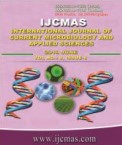


 National Academy of Agricultural Sciences (NAAS)
National Academy of Agricultural Sciences (NAAS)

|
PRINT ISSN : 2319-7692
Online ISSN : 2319-7706 Issues : 12 per year Publisher : Excellent Publishers Email : editorijcmas@gmail.com / submit@ijcmas.com Editor-in-chief: Dr.M.Prakash Index Copernicus ICV 2018: 95.39 NAAS RATING 2020: 5.38 |
Enterococci gained great significance as a nosocomial pathogen in the recent past mainly due to its intrinsic to many antimicrobials including low level aminoglycoside resistance. Detection of the acquired high level aminoglycoside resistance (HLAR) had become essential as clinical failures reported especially with endocarditis. Total of 60 enterococcal isolates were tested (30 from clinical cases as cases and 30 from stool samples as controls) for high level aminoglycoside resistance for gentamicin and streptomycin by three methods -agar dilution, E-test and disc diffusion method. High level gentamicin resistance (HLGR) detected by agar dilution (70%, 3.3%), E-test (63%, 10%) and disc diffusion (46%, 33%) were higher in cases than control samples. HLSR detected by agar dilution (16%, 33%) and disc diffusion (30%, 33%) was also higher in cases than controls. When compared to all three methods, agar dilution and E-test gave nearly same results than disc diffusion method. The present study showed significantly higher rates of HLAR in clinical isolates when compared to isolates from stool samples. This could be due to the fact that clinical isolates are from patients who would have got exposed to various antibiotic while the stool isolates are from healthy people without exposure to antibiotics. Hence routine testing of HLAR is required for all enterococcal isolates especially from serious enterococcal infections.
 |
 |
 |
 |
 |